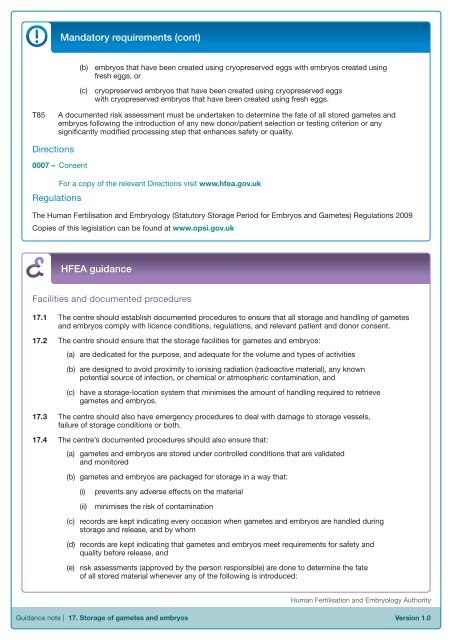Eighth Edition - R.3 - Human Fertilisation & Embryology Authority
Eighth Edition - R.3 - Human Fertilisation & Embryology Authority
Eighth Edition - R.3 - Human Fertilisation & Embryology Authority
You also want an ePaper? Increase the reach of your titles
YUMPU automatically turns print PDFs into web optimized ePapers that Google loves.
Mandatory requirements (cont)<br />
(b) embryos that have been created using cryopreserved eggs with embryos created using<br />
fresh eggs, or<br />
(c) cryopreserved embryos that have been created using cryopreserved eggs<br />
with cryopreserved embryos that have been created using fresh eggs.<br />
T85<br />
A documented risk assessment must be undertaken to determine the fate of all stored gametes and<br />
embryos following the introduction of any new donor/patient selection or testing criterion or any<br />
significantly modified processing step that enhances safety or quality.<br />
Directions<br />
0007 – Consent<br />
For a copy of the relevant Directions visit www.hfea.gov.uk<br />
Regulations<br />
The <strong>Human</strong> <strong>Fertilisation</strong> and <strong>Embryology</strong> (Statutory Storage Period for Embryos and Gametes) Regulations 2009<br />
Copies of this legislation can be found at www.opsi.gov.uk<br />
v<br />
HFEA guidance<br />
Facilities and documented procedures<br />
17.1 The centre should establish documented procedures to ensure that all storage and handling of gametes<br />
and embryos comply with licence conditions, regulations, and relevant patient and donor consent.<br />
17.2 The centre should ensure that the storage facilities for gametes and embryos:<br />
(a)<br />
are dedicated for the purpose, and adequate for the volume and types of activities<br />
(b)<br />
(c)<br />
are designed to avoid proximity to ionising radiation (radioactive material), any known<br />
potential source of infection, or chemical or atmospheric contamination, and<br />
have a storage-location system that minimises the amount of handling required to retrieve<br />
gametes and embryos.<br />
17.3 The centre should also have emergency procedures to deal with damage to storage vessels,<br />
failure of storage conditions or both.<br />
17.4 The centre’s documented procedures should also ensure that:<br />
(a) gametes and embryos are stored under controlled conditions that are validated<br />
and monitored<br />
(b)<br />
gametes and embryos are packaged for storage in a way that:<br />
(i)<br />
(ii)<br />
prevents any adverse effects on the material<br />
minimises the risk of contamination<br />
(c)<br />
(d)<br />
(e)<br />
records are kept indicating every occasion when gametes and embryos are handled during<br />
storage and release, and by whom<br />
records are kept indicating that gametes and embryos meet requirements for safety and<br />
quality before release, and<br />
risk assessments (approved by the person responsible) are done to determine the fate<br />
of all stored material whenever any of the following is introduced:<br />
<strong>Human</strong> <strong>Fertilisation</strong> and <strong>Embryology</strong> <strong>Authority</strong><br />
Guidance note | 17. Storage of gametes and embryos<br />
Version 1.0

















